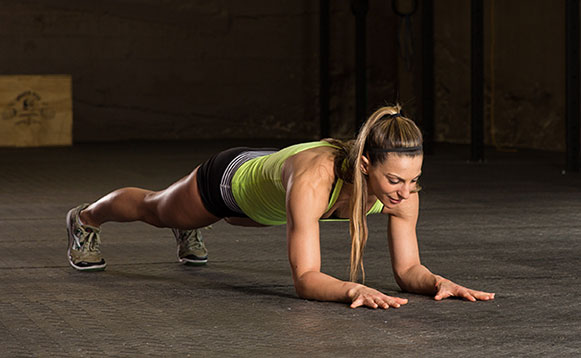
By Jonathan Ross
Static planks are great, but they shouldn’t be considered a goal—they are a starting point. Life is movement and our training should prepare us to do just that. The current record for the longest time in a plank position is three hours seven minutes and 15 seconds. That is beyond difficult to be sure, but it’s also kind of pointless. It’s like a long cardiovascular training session in the form of a plank. If you can hold a plank for three hours, you aren’t necessarily getting any stronger—you can simply hold a plank for a really long time.
Here’s What You Need to Know
Static planks are great, but they shouldn’t be considered a goal—they are a starting point. Life is movement and our training should prepare us to do just that. The current record for the longest time in a plank position is three hours seven minutes and 15 seconds. That is beyond difficult to be sure, but it’s also kind of pointless. It’s like a long cardiovascular training session in the form of a plank. If you can hold a plank for three hours, you aren’t necessarily getting any stronger—you can simply hold a plank for a really long time.
Here’s What You Need to Know
- Done properly, planks are a wonderful exercise for teaching trunk, hip and shoulder stability by integrating a full-body contraction. This is an ideal starting point for activity.
- Once you’ve mastered good plank technique, stop holding it for longer amounts of time and start moving it. Despite the intense muscle burning, long isometrics actually burn the lowest number of calories. Life is movement, not the absence of it.
- Follow a system for developing moving plank options so you know why you are adding any movement to planks.
Whenever I am speaking on the topic of ab training, I always ask the audience, “What’s the purpose of planks?” I am usually met with silence, so I’ll ask the question again, this time letting them know that they are unlikely to offer an incorrect answer. Now, I start to get some responses, most of which are abstract and generic, even if they are correct, such as: “They teach full-body stability.” “They develop good core strength.” “They help prevent back pain.” O.K., but why do I want any of that?
What’s the purpose of having good core strength and full body stability? To do stuff! It’s not a complicated answer. We tend to overcomplicate and sometimes overthink things in fitness. Whatever you (or your clients) want to do—play a sport, play tag with your kids, compete in obstacle races or catch butterflies—you want to feel good when you do it and not have to worry about your body. The same is true for the stuff we all have to do, but may not really love to do (things like doing laundry and yard work or putting away groceries).
Thus, the ultimate purpose of planks is to get better at moving. It makes little sense then to have a core-strengthening program that focuses strictly on the absence of movement. This idea has gotten out of hand to the point where some people erroneously recommend doing only anti-rotation exercises to train rotation. Think about it this way: Sitting behind the wheel of a car that is motionless is not how you learn to drive.
This idea has become popular because some have ascribed to the idea that rotation is “dangerous.” In other news, life is dangerous, so you’d better train for it. Life will ask you to move quickly, randomly and correctly at some point to avoid injury. Proximal strength equals distal power. In other words, strength in the center gives you more powerful, controlled movements.
Keeping still forever in exercise is like staying in first grade forever. You learn planks to be able to do harder things. Planks are very effective for preparing you to do something harder than a plank.
A recent ACE ProSource article examined some of the reasons why planks are, in fact, a great core exercise. The purpose of this article is to take this concept a step further and give you a framework for thoughtfully (not randomly) adding movement into planks. You and your clients can use the following system for introducing movement into your plank training:
1. Partner reactivity
2. Move the torso (center of mass)
3. Move an extremity
4. Translate the body through space/ambulate
5. Combinations (combine elements of steps 1 through 4 to make new variations)
One important concept that flows through all of these examples is that you can vary the speed of movement to manipulate the intensity of any moving plank. Also, just about any plank variation will work with your choice of upper-body support position (i.e., elbow or hand).
Partner Reactivity
Sample Exercise: Side Plank in Suspension Trainer with Impulse Taps
This plank variation adds a stability challenge by having the feet in a suspension trainer, which is then further progressed by having a partner provide reactive taps to the straps.
What’s the purpose of having good core strength and full body stability? To do stuff! It’s not a complicated answer. We tend to overcomplicate and sometimes overthink things in fitness. Whatever you (or your clients) want to do—play a sport, play tag with your kids, compete in obstacle races or catch butterflies—you want to feel good when you do it and not have to worry about your body. The same is true for the stuff we all have to do, but may not really love to do (things like doing laundry and yard work or putting away groceries).
Thus, the ultimate purpose of planks is to get better at moving. It makes little sense then to have a core-strengthening program that focuses strictly on the absence of movement. This idea has gotten out of hand to the point where some people erroneously recommend doing only anti-rotation exercises to train rotation. Think about it this way: Sitting behind the wheel of a car that is motionless is not how you learn to drive.
This idea has become popular because some have ascribed to the idea that rotation is “dangerous.” In other news, life is dangerous, so you’d better train for it. Life will ask you to move quickly, randomly and correctly at some point to avoid injury. Proximal strength equals distal power. In other words, strength in the center gives you more powerful, controlled movements.
Keeping still forever in exercise is like staying in first grade forever. You learn planks to be able to do harder things. Planks are very effective for preparing you to do something harder than a plank.
A recent ACE ProSource article examined some of the reasons why planks are, in fact, a great core exercise. The purpose of this article is to take this concept a step further and give you a framework for thoughtfully (not randomly) adding movement into planks. You and your clients can use the following system for introducing movement into your plank training:
1. Partner reactivity
2. Move the torso (center of mass)
3. Move an extremity
4. Translate the body through space/ambulate
5. Combinations (combine elements of steps 1 through 4 to make new variations)
One important concept that flows through all of these examples is that you can vary the speed of movement to manipulate the intensity of any moving plank. Also, just about any plank variation will work with your choice of upper-body support position (i.e., elbow or hand).
Partner Reactivity
Sample Exercise: Side Plank in Suspension Trainer with Impulse Taps
This plank variation adds a stability challenge by having the feet in a suspension trainer, which is then further progressed by having a partner provide reactive taps to the straps.
HOW TO DO IT: Get into a side plank position in a suspension trainer with the top leg in front. With a lot of the weight on the feet (where there is the most instability), this variation can be a terrific indicator of the ability of the core muscles to absorb and control rapid and unpredictable forces while maintaining balance. (A real-world correlate would be when riding public transportation and there is a change in speed or when another passenger accidently bumps into you.) While holding the plank, the partner provides reactive taps to the straps or perhaps even to the body of the exerciser.
TIPS:
TIPS:
- Having the top leg in front helps keep the hips stacked—putting the bottom leg in front makes it harder to hold stability.
- The tapping partner has a great vantage point to enable coaching of full-body alignment during the plank. In general, looking straight ahead promotes proper alignment as the body will often go where the eyes tell the brain to move it.
Move the Torso (Center of Mass)
Sample Exercise: Plank With Hip Drop
This variation allows for movement of the torso, which is where the body’s center of mass is located, and trains the ability of the arms and leg to be stable with varying amounts of body weight shifting into and out of each limb.
HOW TO DO IT: Get into a plank position. From there, lower to one side as you roll through the feet to lightly touch the outer thigh to the floor. Lift up and back over, passing through the top position of a great plank, and lower down to lightly touch the other outer thigh to the floor.
TIPS:
- Be sure to get all the way back up to the top of a plank in the center.
- If you are unable to touch the floor without an elbow coming up, simply work within a range of motion that allows the arms to stay grounded and progress over time.
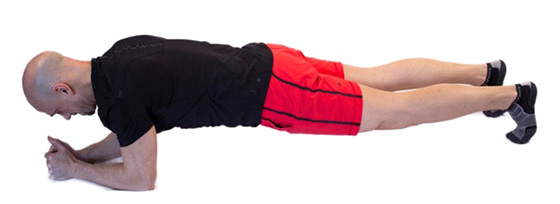

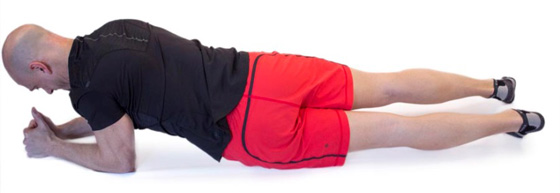
Move an Extremity
Sample Exercise: Plank With Limb Lift
This simple concept provides endless opportunities for plank variations by moving arm(s) or leg(s) in a wide variety of ways.
HOW TO DO IT: Get into a plank position. Lift a limb with control and shift the body weight over the remaining limbs that have ground contact. Lifting an arm is harder than lifting a leg; to lift a leg, keep the feet very close together to start rather than maintaining a wider base of support. The example here shows the most common variation—a leg lift—but this is really just a launching point for endless variations of arm and leg movements.
TIPS:
- Consider moving arms and legs in the sagittal, frontal and transverse planes to aid in creating new variations of your own that provide a movement experience with maps directly to the ACE Integrated Fitness Training Model.
- Adding speed, as in “Plank Jacks” (where your feet hop out and in, as in a jumping jack), is always a possibility once the ability to maintain stability with moving limbs is achieved.
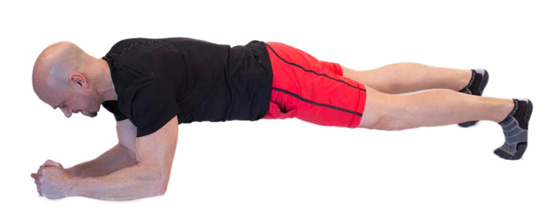
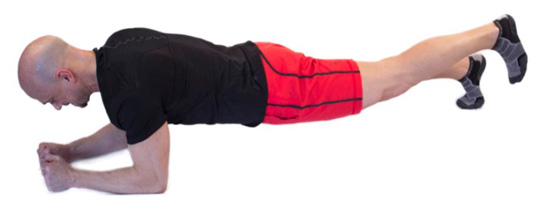
Translate the Body Through Space
Sample Exercise: Walking Plank
Note: For a video demonstration of this exercise and others, along with details on how to form an excellent plank by using muscles of the entire body, check out Ross’s popular ACE video Plank School.
This plank variation builds on skills learned when moving both the limbs and the torso.
HOW TO DO IT: Get into a plank position at one edge of a mat. Begin to “walk” sideways on your elbows and feet until you reach the opposite edge of the mat. Return to the starting position. That’s one rep. Typically, most people’s form will begin to degrade after only three to five reps.
TIPS:
Note: For a video demonstration of this exercise and others, along with details on how to form an excellent plank by using muscles of the entire body, check out Ross’s popular ACE video Plank School.
This plank variation builds on skills learned when moving both the limbs and the torso.
HOW TO DO IT: Get into a plank position at one edge of a mat. Begin to “walk” sideways on your elbows and feet until you reach the opposite edge of the mat. Return to the starting position. That’s one rep. Typically, most people’s form will begin to degrade after only three to five reps.
TIPS:
- Watch for excessive wiggling and rotation of the hips. There will always be some, but when fatigue sets in the ability to move smoothly and with control begins to disappear rapidly.
- For a fun variation, try this face-up (but on hands.) It’s a good idea to do some reverse or supine planking. In grade school, we’d do “crab walks” all the time. Why did we ever stop?
Bonus or alternative exercise: Suspension Trainer “Climbing” Plank
Combinations
Sample Exercise: Plank Walk-in
This plank variation combines multiple strategies discussed in this article: shifting the torso, moving the limbs and translating the body through space.
HOW TO DO IT: From a plank position, walk the feet forward in small steps. Keep the knees low but off the floor and walk them in as far as is comfortable and possible.
TIPS:
- Take small steps and keep the knees low. As fatigue sets in, the tendency will be to take bigger steps and lift the hips higher in the air.
- Add variations, such as walking slightly out to one side as you walk forward or even out to a side plank.
Wrap-Up
Remember, planks are great—they just shouldn’t go on forever. Once you master the skill of performing a plank, it is best to progress to a harder exercise rather than to keep performing this foundational exercise for longer amounts of time. For the majority of people, time is a precious commodity. This means that the time spent exercising must be spent performing the most valuable activities and exercises. And holding a plank for minutes at a time is ultimately a poor way to spend this valuable time when there are better options to more successfully prepare for the unpredictable nature of life’s movement demands. Life is movement, so train for it.
Remember, planks are great—they just shouldn’t go on forever. Once you master the skill of performing a plank, it is best to progress to a harder exercise rather than to keep performing this foundational exercise for longer amounts of time. For the majority of people, time is a precious commodity. This means that the time spent exercising must be spent performing the most valuable activities and exercises. And holding a plank for minutes at a time is ultimately a poor way to spend this valuable time when there are better options to more successfully prepare for the unpredictable nature of life’s movement demands. Life is movement, so train for it.
Комментариев нет:
Отправить комментарий